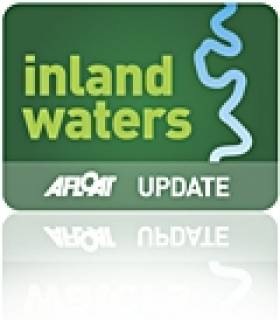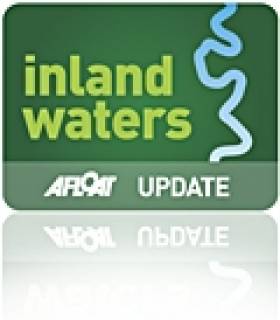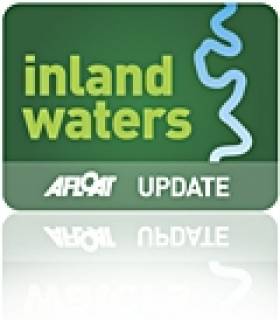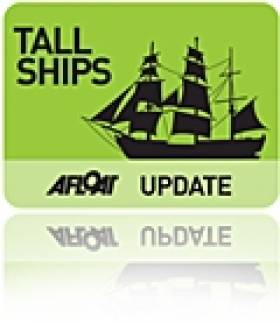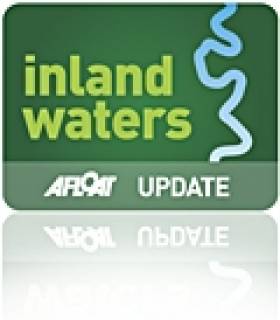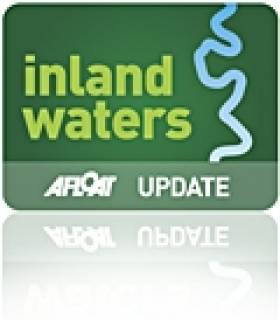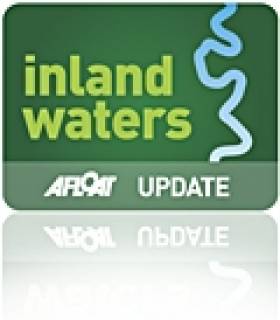Displaying items by tag: Waterways Ireland
New Inland Sponsorship Opportunities for Waterway and Waterside Activity
#inland – Waterways Ireland 2013 Sponsorship Programme for recreational waterway and waterside activity opens on 1 October 2012 for events taking place along the Lower Bann Navigation, the Erne System, the Shannon-Erne Waterway, the Shannon Navigation, the Barrow Navigation, the Grand Canal and the Royal Canal.
Taking place annually for the past seven years the Waterways Ireland Sponsorship Programme has supported angling, canoeing, rowing, sailing and power-sports; competitions, learning experiences, historical and educational activities.
Éanna Rowe, Head of Marketing and Communications with Waterways Ireland stated that "Communities, clubs and associations in towns and villages, along rural waterways and in waterside urban centres, have participated in small and large events. Huge numbers of people have been encouraged to experience something new about the waterways." Mr Rowe added " "the myriad of events supported by Waterways Ireland play a significant role from both an economic and social standpoint in underpinning and supporting the waterway communities and recreational activity along Ireland's Inland Waterways'.
Applications are open to anyone wishing to run recreational waterway and waterside events. For an application pack please contact Damien McWeeney by email at [email protected], by telephone at +353 71 96 50787. Terms and conditions do apply. The closing date the receipt of completed applications is 9 November 2012 at 3pm.
Waterways Ireland, the North/South Implementation Body is responsible for the management, maintenance, development and restoration of the inland navigable waterway systems throughout the island, principally for recreational purposes.
Grand, Royal Canal & Barrow Navigation Mooring Rules Come into Force
#inland – Waterways Ireland announced in June 2012 that the Canal Bye-laws on the Grand & Royal Canal and Barrow Navigation are to be enforced from autumn 2012, with an accompanying change in the permit system allowing for year-long mooring permits and locations.
Part of bringing in this new location-based permit has been the identification of locations suitable for extended mooring. This process is now completed and work has begun in some areas to improve accessibility.
Waterways Ireland will roll out Extended Mooring Permit applications by area, rather than giving a date when applications for the permit will open. For boat owners this will mean that enforcement of the maximum stay rule will not commence in an area until after boat owners have had the opportunity to purchase an Extended Mooring Permit.
The initial 12 month Extended Mooring Permit will cost €152 and will only be available to boats already holding a valid annual Mooring and Passage Permit.
Boats that cruise and move (staying at a mooring for up to 5 days) will not be in breach of the Bye-laws or require an Extended Mooring Permit.
Waterways Ireland has proposed a small number of draft amendments to the current Bye-laws which date from 1988. These include proposals to provide a range of charges for mooring permits that reflect the location and services provided throughout the canals and also will take into account the size of boat. These proposals include low cost rural moorings on soft banks to ensure the canals are accessible for everyone who owns a boat and requires a mooring. Boat owners allocated an extended mooring location in key areas in villages or towns or with services should be aware that if the new Bye-laws are approved Waterways Ireland will increase the charges for moorings in the future to reflect the location, services, and size of boat.
Waterways Ireland recognises the current situation whereby a small number of boat owners use their boats as their sole or permanent residence. Proposals to make provision for this use of the navigation property have been included in the Bye-law changes.
Furthermore Waterways Ireland intends to work towards the provision of a small number of serviced house boat moorings on the canal network. Such provision will be subject to finance, land availability and compliance with requisite statutory approvals.
Waterways Ireland recognises that a transition period of a number of years will be required to implement this. In the interim these boat owners should apply for an Extended Mooring Permit.
The draft Bye Law amendments are currently being considered by Waterways Ireland's sponsor Departments. When Waterways Ireland has Ministerial consent, it will proceed to public consultation on the proposed Bye-law amendments.
Waterways Ireland will continue to contact permit holders regularly to ensure they are kept up to date with the roll-out of the new permit. All queries about the enforcement of the current bye-laws or the Extended Mooring Permit should be directed to Shane Anderson, Assistant Inspector of Navigation: Tel no +353 (0)87 286 5726, Email [email protected] . Queries about houseboats should be directed to Property & Legal Section Tel no +44 (0)28 6632 3004.
These changes are necessary steps to improve the management of the canals and waterway amenities for both the navigational and recreational user, so that investment in the new infrastructure and facilities which Waterways Ireland has undertaken is maximised for every user.
Winter Mooring Season Begins on River Shannon Navigation
#inland – Waterways Ireland facilitates owners to keep their vessels and boats at its public harbours over the winter period on the Shannon and Shannon-Erne Waterways. The upcoming winter mooring period begins on 1 Nov 2012 and will end on the 31 Mar 2013. The fee charged for this facility is €63.50 for the five month period.
Owners wishing to take advantage of this facility are advised to write to the Waterways Ireland Inspectorate, The Docks, Athlone, indicating their intention to take a winter mooring, give the specific location, boat registration number and enclose advance payment of €63.50 by cheque, bank draft or postal order made payable to Waterways Ireland. Credit card payments can also be made over the phone by contacting 353 (0)90 9741165. Payment must be received prior to 1 Nov 2012.
Boats owners that have not contacted the Inspectorate and made the advance payment must continue to observe the mooring time limits for public harbours i.e. the "5 Day Rule", which still applies and will be enforced during this period (Bye-law 17. Mooring and Use of Harbours).
Anyone with queries regarding winter mooring or the enforcement of the Bye-laws should contact the Inspector of Navigation +353 (0)906 494 232.
Waterways Notice: Royal Canal Closure in Meath, Lower Bann Lock Restrictions
#INLAND WATERWAYS - Waterways Ireland has issued notice of a planned closure of the Royal Canal in Clonard, Co Meath over the winter months, as well as restrictions on the Lower Bann this coming Wednesday.
In Clonard, the stretch of the canal between Blackshade Bridge and Hill of Down will be closed from 1 October 2012 till 17 March 2013 to facilitate essential bank strengthening works.
Waterways Ireland wishes to thank all owners and masters of vessels using the Royal Canal for their co-operation in this matter.
Meanwhile, on the Lower Bann there will be an interruption to electricity supply in the Movanagher area in Co Derry this Wednesday 19 September.
All owners and masters are advised that there will be restricted access to Movanagher Lock and swing bridge on that date, and vessels of more than 26 feet (8 metres) will not be permitted to make passage.
First Irish 'Sail Raid' Begins on Inland Waterways
#sailraid – Not since the Vikings has a group of boats set off sailing southwards with such a challenge!
Over 20 sail boats with crews from Japan, France, Sweden England and Ireland will participate in the Lakelands & Inland Waterways International Sail Raid 2012 taking place from 14th to 21st September 2012 from Lough Erne to Killaloe Co. Clare. The crews will sail their boats the distance in 7 days in a series of race stages. An immense challenge but a fun and exciting initiative, this is the first time it has been undertaken in Ireland or Northern Ireland.
A fun, competitive sailing event for teams of 2-3 people, using Shannon One Designs, Waterwags, and an Open Class of boats including Drabscombes, the international teams will be welcomed at Lough Erne Yacht Club for the opening night and briefing before the journey begins. Domestic sailors are also welcome to participate.
Organised by Albacore/Dacmar events "Lakelands & Inland Waterways International Sail Raid 2012" will be run in close cooperation with the Lough Erne, Lough Ree and Lough Derg Yacht Clubs and with the assistance of the Dublin National Yacht Club.
Raid General Manager Jymmy Viant stated "the Lakelands & Inland Waterways International Sailing Raid 2012 is a long distance race with one or two legs every day and a different stopover every night. The "Lakelands & Inland Waterways International Sail Raid" will, to our knowledge, be the first raid run with traditional Irish Sailing Boats, among the oldest classes in the world. We expect international teams to relish this amazing opportunity to explore Ireland's inland waterways in such unique boats".
Eanna Rowe Waterways Ireland, Head of Marketing & Communications and Co-Chair of Lakelands & Inland Waterways stated "The Lakelands & Inland Waterways International Sail Raid is a superb opportunity to bring the awareness of an international audience to Ireland's inland waterways. There is a real opportunity for regular raid enthusiasts from all over the world and for sailors from all over Ireland to join in this unique experience."
Lakelands & Inland Waterways is a tourism product development & marketing initiative of Waterways Ireland, Fáilte Ireland, Shannon Development, Fermanagh Lakeland Tourism and Tourism Ireland.
#TALL SHIPS - Waterways Ireland has announced a series of events around Grand Canal Dock in support of the Tall Ships Races Festival.
The events will be centred around the Waterways Ireland Visitor Centre on Grand Canal Quay, with a full programme of children’s art and craft workshops and two exhibitions running throughout the festival. The programme includes:
'A Very Grand Canal' Art Exhibition
A Very Grand Canal is a collection of artistic responses to the Grand Canal commissioned by Offaly County Council through the Per Cent for Art scheme. Three projects were chosen, some with multiple outcomes, all illuminating the Grand Canal in ways not seen, heard or read before. The artists include, Geraldine O’Reilly (printmaker), La Cosa Preziosa (sound artist), Martina McGlynn and Garret Daly (Filmmakers), Eugene O’Brien (writer) Veronica Nicholson (photographer) and Wayne Brennan (musician). The exhibition runs throughout the Tall Ships festival from 10am to 6pm daily.
Small Ships at the Tall Ships
Small Ships at the Tall Ships is an exhibition of work by the Irish Model Boat Club, featuring small tall ships, RNLI lifeboats and a 16ft model of the Titanic. There will also be a demonstration of radio controlled model boats, and a model boat building workshop for children 7 and up (call 01 677 7510 to book; places are limited). The exhibition is open daily throughout the festival.
Waterways Ireland Community Choir
The Waterways Ireland Community Choir’s members are local people from the Docklands and along the canals coming together to sing songs of the rivers, canals and docks. Their performance on the jetty of the Waterways Ireland Visitor Centre at 4pm on Saturday 25 August will feature a wide repertoire of songs including Simon & Garfunkel’s 'Bridge Over Troubled Water' and the more light-hearted traditional song 'Drunken Sailor'.
'Decorate Your Duck' Workshop
Who will have the best looking duck in the Duck Race? The Decorate Your Duck workshop runs in the Waterways Ireland Visitor Centre on Saturday and Sunday from 11am to 3pm. There will be glitter and glue, paint and polish, so come on down and give your duck some character! The Duck Race is run in aid of St Andrews Resource Centre, Pearse Street.
'Watery Stories' with Púca Puppets
Niamh from Púca Puppets invites the young (and young at heart) to meet 'canalmaid' Mary Mary, who will pull ashore at the Waterways Ireland Visitors Centre for the Dublin Tall Ships Festival and is looking for help in finding clues, creating and drawing stories to illustrate life on and in Ireland's canals and inland waterways. Suitable for 6-10 year olds and their families, Watery Stories takes place on Friday 24, Saturday 25 and Sunday 26 August at 11am and 2pm. Booking is advisable as places are limited - phone 01 677 7510.
#INLAND WATERWAYS - Waterways Ireland has applied for planning permission to build a new houseboat mooring facility on the Grand Canal at Sallins in Co Kildare.
The planned 210-metre fixed timer mooring is expected to cater for 12 boats with electric and water service supply bollards as well as a sewage pumpout.
There will also be 45 metres of short-term mooring space, a 12-space car park and disabled access to the facility.
Submissions on the planning application will be accepted by Kildare County Council till 11 September 2012. Details are available via the council's online planning system (application number 12645).
As previously reported on Afloat.ie, Waterways Ireland launched a scheme earlier this year for renting houseboat berths at the western end of the Grand Canal at Shannon Harbour.
#INLAND WATERWAYS - Northern Ireland will welcome avid fans of watersports from across the UK and Ireland next month when the Waterways Ireland Riverfest returns for 2012.
Christie Park between the bridges in Coleraine will play host to the Riverfest for a sixth consecutive year on Saturday 11 and Sunday 12 of August.
Over the years this family-orientated event has attracted tens of thousands of visitors to Ireland's inland waterways, and this year a full programme of water- and land-based activities is sure to entertain and engage, including waterskiing, jetskiing, wakeboarding and barefooting by a team of world-class athletes.
Following on from the success of previous years' events, Riverfest will highlight the cream of Irish talent with shows from the Xtreme Action Team headed by Ant Burgess, wowing the crowds with inverts of up to 20ft.
The Waterways Ireland Wakeboard Open Championship will bring together the 30 best wakeboarders from all over Ireland to compete in a two-round competition over the weekend. (Wakeboarders click HERE for details on how to take part.)
Also in the line up is Caite Skelly, a 14-year-old from Coleraine who will be barefoot waterskiing at over 40mph.
Event organiser Rob Skelly said: “The Waterways Ireland Riverfest has been a phenomenal success since we launched five years ago. For 2012, the line-up will be bigger and better cementing its reputation as one of the best water-sports events across the UK and Ireland."
#INLAND WATERWAYS - The Lakelands & Inland Waterways Ireland Sailing Raid is a unique event combining sailing, adventure, exploration and racing in the setting of some of the most stunning countryside in Western Europe.
On 14-21 September a fleet of about 40 'open' boats – including the 5.5-metre Shannon One Design, the 4.5-metre Water Wags and various traditional styles and new builds all under 7.5 metres long – will sail 190km from Lough Erne in Northern Ireland, through the River Shannon and across the great lakes of Lough Ree and Lough Derg to Killaloe.
Although it will be a competitive race, there will be some time left to enjoy the scenery and the Irish hospitality of the three participating yacht clubs along the way. Some will come for the racing, some for the scenery, some for the spirit of comraderie – but everyone is sure to enjoy the craic.
To maintain the maritime nature of the event, the Lakelands & Inland Waterways Ireland Sailing Raid will be based as much as possible on the water.
Accommodation will be provided in motor cruisers for those who want it, while some will be able to camp near the river bank and others will make their own arrangements. Each stopover will therefore bring together participants in a 'floating village', with several receptions and festivities in the evenings.
The event is being organised in close collaboration with Waterways Ireland, with logistical support will be provided by the three main yacht clubs on the route: Lough Erne Yacht Club, Lough Ree Yacht Club and Lough Derg Yacht Club.
Members of the local clubs are being invited to take part at a preferential rate, while raid competitors from all over Europe will provide an international element to the event.
For more information and application details, visit the Sailing Raid website at www.sailing-raids.com.
#inland – Boat owners need to be careful about not overstaying at any one mooring after Waterways Ireland successfully undertook the prosecution of two boats owners on Lough Erne for breaching the 48 hour mooring Bye-law. The defendants received a caution and undertook to comply with the Bye-laws in the future.
Waterways Ireland communicates regularly with boat owners about the Bye-laws and has produced a publication "Good Boating Guide" advising boat owners of the Bye-laws on Lough Erne.
Having recorded breaches of the 48 hour mooring Bye-laws, Waterways Ireland wrote to the boat owners advising of the breach and after subsequent breaches were noted, Waterways Ireland reluctantly brought the prosecutions under the Bye-laws.
The Magistrate, Mr. Kennedy, commented that "the Prosecutions were properly brought and it is important that people comply with the Bye-laws. "
Brian D'Arcy, Waterways Ireland's Director of Operations stated "Waterways Ireland had no option but to prosecute following the increasing numbers of local boat owners abusing moorings provided for visiting tourist boats. Waterways Ireland provides moorings free of charge to enable tourists and touring boat owners to access attractions, services, towns and villages. Particularly in Enniskillen, the moorings facilitate the tourism economy as boaters spend in shops and restaurants; reduced access means less income for the town. Waterways Ireland would like to ensure all boat owners are made aware of their responsibilities when using public moorings and do not leave their boats moored in one location on a public mooring for more than 48 hours."
For more information boaters can download a copy of the Good Boaters Guide from the Waterways Ireland website or order a copy free from the Webshop www.waterwaysireland.org.




























